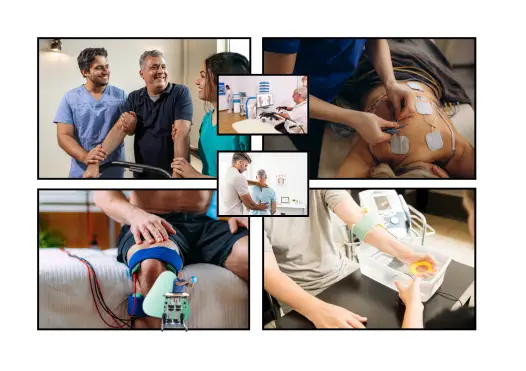- info@delta-biomechanics.com
- 5th Floor, Delta Health Care Chattogram Limited, 28, Mirzapul Road, Katalgonj, Panchlaish, Chittagong.

A stroke is a life-changing event that can affect movement, speech, and independence. For many patients and their families, the recovery journey feels long and uncertain. Traditional physiotherapy is essential, but new treatments like electrotherapy are helping stroke survivors recover more quickly and effectively. If you or a loved one is on the road to recovery, understanding how electrotherapy works could give you hope and confidence.
🔹 What is Electrotherapy?
Electrotherapy is a modern rehabilitation technique that uses mild electrical impulses to stimulate nerves and muscles. These impulses are delivered through small pads placed on the skin. They are painless and safe, and they help “wake up” the muscles and nerves that may not be functioning well after a stroke.
Unlike surgery or medication, electrotherapy is non-invasive. It is often combined with physiotherapy exercises to accelerate recovery. For stroke patients, it can be a powerful tool to rebuild strength, coordination, and independence.
🔹 Why Stroke Patients Benefit from Electrotherapy
After a stroke, many patients struggle with weakness, stiffness, or difficulty moving one side of their body. Some even lose the ability to perform simple daily activities like walking, holding objects, or getting dressed. Electrotherapy directly targets these problems in several ways:
1. Muscle Activation and Strengthening
Stroke often leaves certain muscles weak or inactive. Electrotherapy sends gentle signals to those muscles, making them contract and “practice” movement. Over time, this helps the muscles grow stronger and respond better during exercises.
2. Improving Brain-Muscle Connection
One of the biggest challenges after a stroke is that the brain’s normal pathways to control movement are disrupted. Electrotherapy assists by stimulating nerves and muscles, which encourages the brain to create new pathways. This process, called neuroplasticity, helps patients relearn how to move.
3. Reducing Spasticity and Stiffness
Many stroke survivors experience muscle tightness or spasms (spasticity), which can make daily activities painful or impossible. Electrotherapy relaxes muscles, reducing stiffness and allowing smoother, more natural movements.
4. Pain Relief
Some patients suffer from nerve pain or muscle discomfort after a stroke. Electrotherapy can block certain pain signals, making rehabilitation less painful and easier to continue.
5. Boosting Blood Circulation
Good circulation is essential for healing damaged tissues. Electrotherapy improves blood flow in the treated area, bringing oxygen and nutrients that support recovery.
🔹 How Electrotherapy Fits into Rehabilitation
It’s important to remember that electrotherapy is not a cure by itself. It works best as part of a complete rehabilitation program, which may include:
When used together, these therapies give patients the best chance to regain independence.
🔹 Safety and Comfort
Many patients worry if electrotherapy is safe. The good news is that it is completely safe when used under professional guidance. The intensity of the electrical impulses is always adjusted based on the patient’s condition, so it never feels painful. Most patients describe the sensation as a mild tingling or gentle tapping.
At advanced rehabilitation centers Electrotherapy For Stroke Patient specialists carefully assess each patient before starting electrotherapy. This ensures treatments are personalized, effective, and risk-free.
🔹 Real Benefits for Stroke Survivors
Research and patient experiences show that electrotherapy can:
Even small improvements, like being able to grip objects or walk a few steps without support, can make a huge difference in a patient’s confidence and quality of life.
🔹 Final Thoughts
Recovering from a stroke is never easy, but modern treatments like electrotherapy are making the journey faster and more successful. By strengthening weak muscles, improving brain-to-muscle communication, and reducing stiffness and pain, electrotherapy gives stroke patients the chance to reclaim their independence.